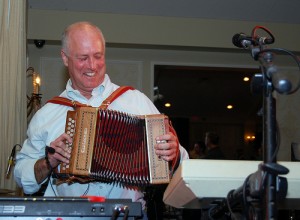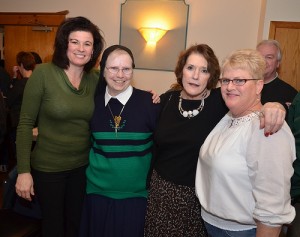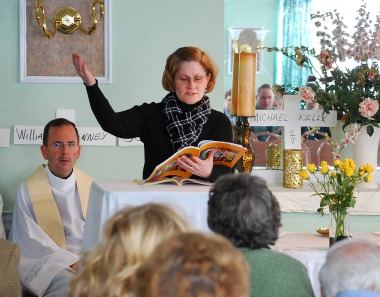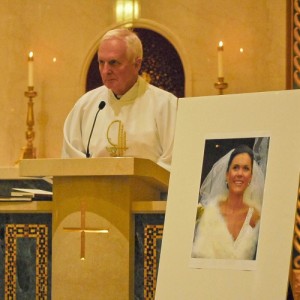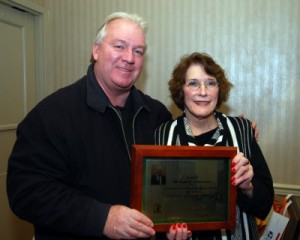
The Bogside artists, Tom and William Kelly, and Kevin Hasson, in front of the original "Death of Innocence" mural in Derry.
This year, Derry was named the first ever UK City of Culture for 2013, a “precious gift for the peacemakers,” in Northern Ireland, said British Prime Minister David Cameron when announcing the award last July .
Derry’s bid, of course, made note of its many cultural contributions to the world, from musician Phil Coulter to Nobel Prize-winning poet Seamus Heaney, but it also frankly acknowledged its tragic history as the birthplace of “the troubles” in the late 1960s.
Nearly 40 years ago this Sunday, simmering tensions boiled to the surface when British soldiers opened fire on a largely peaceful crowd of protestors marching through the city’s Roman Catholic Bogside section, killing 13 people, most of them teenaged boys, and wounding 13 others. The event, which came to be known as “Bloody Sunday,” marked the beginning of decades of armed conflict that largely ended after the so-called “Good Friday Agreement” in 1998 that dissolved direct London rule of Northern Ireland.
Last year, in releasing what is known as the Saville Report on the incident, Cameron became the first British government official to admit that the shootings were “unjustified and unjustifiable,” though none of the troops involved have ever been charged with any crime.
The Derry proposal opens with the lines from a Heaney poem that reflects both the city’s violent past and optimism for the future:
“So hope for a great sea change
On the far side of revenge
Believe that a farther shore is reachable from here.
Believe in miracles and cures and healing wells.”
And in one place—the walls that line the length of Rossville Street in the Bogside—violent history co-exists with a hope for peace in the murals of the three men known collectively as the Bogside artists. Called “the most prominent political murals in the world,” the 12 large scale paintings, all done on dwellings with the permission of the homeowners, are the work of brothers Tom and William Kelly, and friend, Kevin Hasson, all Bogside natives, who started the art project in 1993. The mural that greets you when you enter what the artists call “The People’s Gallery” is a black and white depiction of a boy in a gas mask called “The Petrol Bomber;” one of the last, the “peace mural” in color, featuring a Picasso-like dove on a backdrop of colored squares.
We recently talked to artist Tom Kelly by phone from the Bogside Artists Studio behind the Bogside Inn in Derry.
What was your purpose in painting the murals?
We were acutely aware that a lot of the artists in Ireland, both north and south, were not really dealing with the issues going on on our doorsteps. Most murals tend to be one side or the other. We wanted to bring something artistic into the whole mural arena and create a cathartic experience, a human document that would tell the story of the Bogside and Derry and 40 years of conflict. By looking at it and examining it, we thought that maybe we could move on from it. When you take something and put it into the light, it loses its power.
You all went to art school?
Yes. I spent a year in art college at Jordanstown University and was dissatisfied with the direction the tutors were trying to take us. . . .The idea that a pile of stones on the floor with a dead fish on top was supposed to be the meaning of life, that whole thing I just couldn’t take anymore. So I dropped out. Or maybe I dropped in.
Is that why the murals are done in such a realistic style?
Yes, it’s not about intellectualizing. We could easily have done all that, gone on the conceptual trip. But if good art is about communication, then why write a letter to your grandmother in Greek when you know she doesn’t speak it?
You painted the earliest ones like the Petrol bomber, the Bloody Sunday mural, Civil Rights, the Rioter —most of which are in black and white—while the conflict was still going on. Was that dangerous?
We were all listed for execution, put on a hit list of the UVF [Ulster Volunteer Force, a loyalist paramilitary group]. Most artists would have packed their bags and left. But once we knew we had the support of the people of the Bogside, we went back continually, year after year, to paint the story. We felt we were re-appropriating our story from the British media and telling it for ourselves. We felt very muc like we were commissioned by the community, and the people still support us and them today.
How did you get permission to paint on the walls—aren’t they’re people’s houses for the most part?
We painted them on 12 large gable walls there so we needed the support of the poople. Most murals in the North were put up by paramilitary groups—they would appear overnight on a gable wall and people who lived there were too afraid to pull it down. We went to people, showed them the image, and we were not funded by the government. The donations from local families are what enabled us to hire scaffolding and pay for paint. And we three artists painted them ourselves. And the truth is, it was quite a gas doing the murals. People would come by and talk about things they otherwise might not talk about. Sometimes they would bring tea and scone bread.
Why did you decide to do murals instead of regular-sized paintings?
We’re all small, under 5’7”, it might be a psychological thing. [laughter]
Do you actually conceive the ideas for the murals together?
We spend a lot of time prior to painting a mural getting the right questions together. It’s a bit of hard work really, design work. We like classical design, and it’s the simplicity of the images that’s important to us. We’ve seen murals everywhere and it might sound conceited but most of them suffer from clutteritis. They say too much with the wall space. They tend to be very colorful, but what it’s saying is less important. Though we’re three very different people there’s tremendous harmony among us. We sing from the same songsheet when it comes to murals, art and sculpture
Do you have a favorite of the murals?
That would have to be “Death of Innocence,” the mural of the young girl.
I read somewhere that you knew this young woman whom you’ve portrayed wearing her school uniform with a broken gun to her right and a butterfly above her head. And that you added the broken gun and butterfly much later.
She’s Annette McGavigan, a full cousin of Kevin’s and a good friend of mine. It was the only mural we did where we deliberately left it unfinished. At the time, we couldn’t see any possibility of reconciliation and peace. We said we would finish the mural, breaking the gun in half and showing the butterfly in all its color and energy, when guns no longer killed children.
Tell me about Annette.
She lived in my same street and was interested in art like myself. She was 14 years in 1971. She was sent out by her teacher to gather materials for a still life and there was a skirmish in the street. In the 1970s the soldiers fired plastic bullets. Annette was shot by a British soldier with two high velocity rounds to the back of the ear. She died in her school uniform, which we showed to represent all the kids who died, Irish, Protestant or Catholic. It made it clear—this beautiful child is juxtaposed with fragmentation and a crazy background reminiscent of a bomb explosion. There were these two young boys killed by the IRA in Warrington near London—Jonathan Ball and Tim Parry-and we contacted their parents to ask them if it would be okay if Annette McGavigan could represent them too and they sent us a lovely letter agreeing.
When did you finish the mural?
We went back in 1997, the whole community turned out, including this young girl’s family, to watch us break the gun in half and finish the butterfly in color. We had never forseen it. We thought it would be like the Middle East, there would never be any real peace here.
The Bogside murals have become quite a tourist attraction in Derry. I understand you sort of bring them around the world too.
We get invitations from all over to give lectures and presentations and we have a traveling exhibition. We were invited to China and spent three days in Shenzhen and we did a large mural there for the Dafen Museum—quite a brave step, since it points out that there’s a need for freedom in art, which we actually wrote on the mural. That caused a bit of a stir. We did a version of our peace mural at the Smithsonian Folk Life Festival on the mall in Washington, DC, and we did an exhibition a few years ago at Villanova University. We’ve also done a series of murals at Hanover College (in Indiana), Georgia Southern University, the University of Wisconsin at Madison, and may be coming back to the US to do two or three at DePaul University in Chicago.
You know that Philadelphia is well known worldwide for its murals. We have more than 3,000, probably more than any city. Would you be willing to take a shot at one here?
We just need someone to invite us and pay our way.
I know you’re involved in a campaign now to get the city of Derry to provide lighting for the murals so they can be seen at night.
For its big 2013 celebration, the city is lighting the city walls, St. Columb’s Cathedral, the Apprentice Boys Hall and other key heritage sites, but the murals are staying in the dark. We’re asking people to sign a petition asking the city to provide spotlights. You can do it online at the petition site.
To commemorate Bloody Sunday, the Sons and Daughters of Derry–Philadelphia’s Derry Society–is sponsoring a Mass at the Irish Center, 6815 Emlen Street, Philadelphia, on Sunday, January 30, at 3 PM.
You can see more photographs of the murals at the Bogside Artists’ website.
